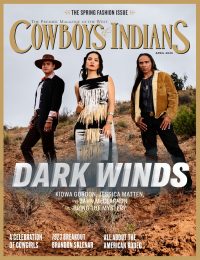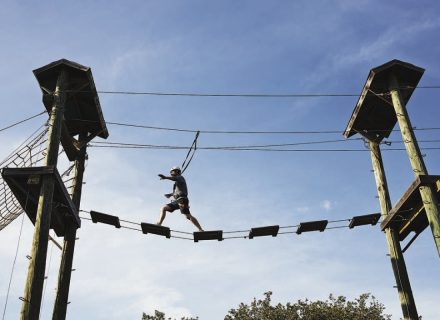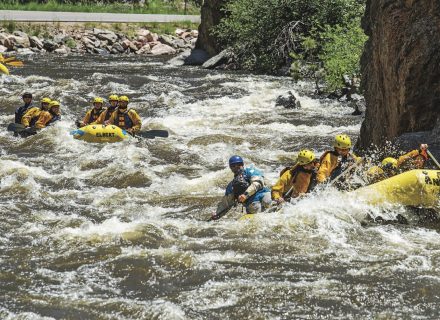A new state park in historically rich western Kansas protects fragile formations that settlers likened to the holy city.
No one knows for sure how Little Jerusalem Badlands got the name, but around this part of northwest Kansas, that’s what the surprising limestone formations rising from the prairie have been called for as long as anyone can remember. Did miners heading to the Colorado gold fields beginning in 1859 or settlers traveling across Kansas on the Smoky Hill Trail in the 1860s see them in the distance and think they resembled the walled holy city?
Artist-historian Jerry Thomas thinks so. The recipient of the 2019 Butterfield Trail Association’s Ambassador’s Award for “his outstanding work in preserving the history of the Smoky Hill Trail and promoting the knowledge and understanding of the trail in his accurate, beautiful, and meticulously detailed artwork,” Thomas has the bona fides: “My grandmother was delivered by the wife of a 7th Cavalry trooper named Thomas Lamb who rode with Lt. Col. Custer. The families had settled near each other in this rich, historic corridor that was once traversed by Plains warriors, cavalry troops, and cowboys,” says Thomas, who was raised in nearby Scott City and runs a gallery and museum there. “I heard many stories about the landmarks and history of the area. Many of the landmarks were given names by the early travelers, such as the Monument Rocks on the Butterfield Overland Trail, or Punished Woman’s Fork named by the Cheyenne. Little Jerusalem was the name given by the early settlers in the area who thought that the spiraling columns of limestone emulated the towers of Jerusalem.”
The name Little Jerusalem became attached to the place and was the natural choice for a new state park and stop on Western Vistas Historic Byway. For generations, the 220-acre mile-long swath of chalk bluffs and spires that now make for the dramatic main attraction of the 330-acre Little Jerusalem Badlands State Park belonged to the private McGuire ranch, so few people had seen Little Jerusalem for themselves. Credit Jim McGuire and family, who inherited the land in 2015, with sharing their family’s special piece of property. The McGuires were determined to make wider access possible if they could find a buyer who could allow the public to visit while also protecting the site. Declining proposals for a fossil dig, off-roading trails, and an exclusive hunting preserve, they ultimately sold to The Nature Conservancy, which owns the adjoining 17,000-acre Smoky Valley Ranch. The Nature Conservancy partnered with the Kansas Department of Wildlife, Parks & Tourism to create Little Jerusalem Badlands State Park. Opened to the public in October 2019, the park features marked trails to maximize views of the rock formations, some towering more than 100 feet.
Here you’re close to Monument Rocks, another icon for pioneers following the Smoky Hill River on the Smoky Hill Trail. While Little Jerusalem’s formations are almost canyonlike, Monument Rocks — also known as Chalk Pyramids — jut 50 to 70 feet up from the prairie. Both Little Jerusalem and Monument Rocks are remnants of the inland sea that covered the central U.S. about 80 million years ago. Now wild buckwheat in the wind makes the only waves, but the fragile sedimentary limestone of the area abounds in fossils of ancient marine life.
If you go, allow time for historic Lake Scott State Park for camping, fishing, canoeing, swimming, and paddle-boating. There are trails for hiking and horseback riding, and there’s history to explore at El Cuartelejo pueblo, the remains of a seven-room structure believed to have been built by Taos and Picuris Pueblo Indians escaping Spanish rule in New Mexico in the 1650s. A mile south of the park, the 30-acre Battle of Punished Woman’s Fork National Historic Site memorializes Kansas’ last Indian military engagement, which saw Lt. Col. William H. Lewis mortally wounded as he pursued chiefs Dull Knife and Little Wolf leading displaced Northern Cheyenne in an attempted exodus in 1878 from a reservation in Indian Territory to their homeland in Montana and Wyoming. “The Northern Cheyenne consider it as ‘the place where they received life again,’ ” says Thomas, who is an honorary member of the Northern Cheyenne Nation.
In nearby Scott City, plan an afternoon at El Quartelejo Museum and the Jerry Thomas Gallery and Collection, which showcases the Kansas native’s Western art and collection of cavalry, battlefield, and Native American artifacts, including items from the Little Big Horn, Lt. Col. George Custer, Frederick Benteen, famous frontier scout Ben Clark, and the Battle of Punished Woman’s Fork. Named by former Kansas Gov. Sam Brownback as chairman of the Scott State Park Historic Preservation and Development Committee, Thomas heads up the building of a new interpretive center at El Cuartelejo over the existing ruins, which have been listed by the National Park Service as “severely distressed.”
For more info, visit scottcityks.org, travelks.com, or jerrythomasartgallery.com.
Photography: Images courtesy The Nature Conservancy/Bruce Hogle
From our May/June 2020 issue.















